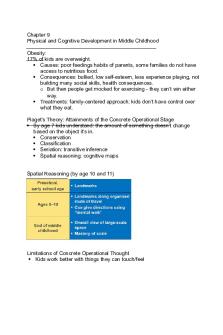Middle Adulthood Physical and Cognitive Development PDF

| Title | Middle Adulthood Physical and Cognitive Development |
|---|---|
| Course | Lifespan Psychology |
| Institution | Algonquin College |
| Pages | 2 |
| File Size | 73.4 KB |
| File Type | |
| Total Downloads | 120 |
| Total Views | 146 |
Summary
Describes how the body is when you are in middle adulthood, which changes occur during this time period in your life....
Description
Week 9 Lecture Middle Adulthood: Physical and Cognitive Development -
Baby Boomers are those people who are born between 1946-1965; today they are middleaged adults. Cognitive development is at its peak during middle adulthood as long as diet and exercise are looked after.
Physical Development -
Interindividual Variability no two people age in the same way or at the same rate. Physiological aging changes in the body’s integumentary system, senses, reaction time, and lung capacity.
Sensory and Auditory Functioning -
Changes in vision occur mid-30’s. Presbyopia loss of elasticity in the lens that makes it harder to focus on, or accommodate to, nearby objects or fine print; result is middle-aged adults may need reading glasses. Presbycusis loss of hearing over time and impacts the elderly most.
Lung Capacity -
Lung tissue stiffens with age; diminishing capacity to expand, such that breathing capacity may decline by half between early adulthood and late adulthood; regular exercise can offset this loss; first beginning to exercise in middle adulthood can expand breathing capacity beyond what it was earlier in life.
Lean-Body Mass and Body Fat -
Lean-body mass, especially muscle, declines with age. Rate of loss accelerates after age 45; fat replaces lean-body mass, which includes muscles.
Muscle Strength -
Loss of muscle reduces strength. Change is gradual. Exercise can compensate by increasing the size of remaining muscle cells. Exercise will contribute to vigour, health, and a desirable body shape.
Bone Density Health
Bones begin to lose density at around the age of 40; as bones lose density, they become more brittle and prone to fracture. Bones in the spine, hip, thigh and forearm lose the most density as we age.
-
People aged 40-65 in developed nations is better than is has ever been.
Leading Causes of Death -
Cancer, heart disease, and accidents; all preventable....
Similar Free PDFs

Chapter 11: Middle Adulthood
- 4 Pages
Popular Institutions
- Tinajero National High School - Annex
- Politeknik Caltex Riau
- Yokohama City University
- SGT University
- University of Al-Qadisiyah
- Divine Word College of Vigan
- Techniek College Rotterdam
- Universidade de Santiago
- Universiti Teknologi MARA Cawangan Johor Kampus Pasir Gudang
- Poltekkes Kemenkes Yogyakarta
- Baguio City National High School
- Colegio san marcos
- preparatoria uno
- Centro de Bachillerato Tecnológico Industrial y de Servicios No. 107
- Dalian Maritime University
- Quang Trung Secondary School
- Colegio Tecnológico en Informática
- Corporación Regional de Educación Superior
- Grupo CEDVA
- Dar Al Uloom University
- Centro de Estudios Preuniversitarios de la Universidad Nacional de Ingeniería
- 上智大学
- Aakash International School, Nuna Majara
- San Felipe Neri Catholic School
- Kang Chiao International School - New Taipei City
- Misamis Occidental National High School
- Institución Educativa Escuela Normal Juan Ladrilleros
- Kolehiyo ng Pantukan
- Batanes State College
- Instituto Continental
- Sekolah Menengah Kejuruan Kesehatan Kaltara (Tarakan)
- Colegio de La Inmaculada Concepcion - Cebu














